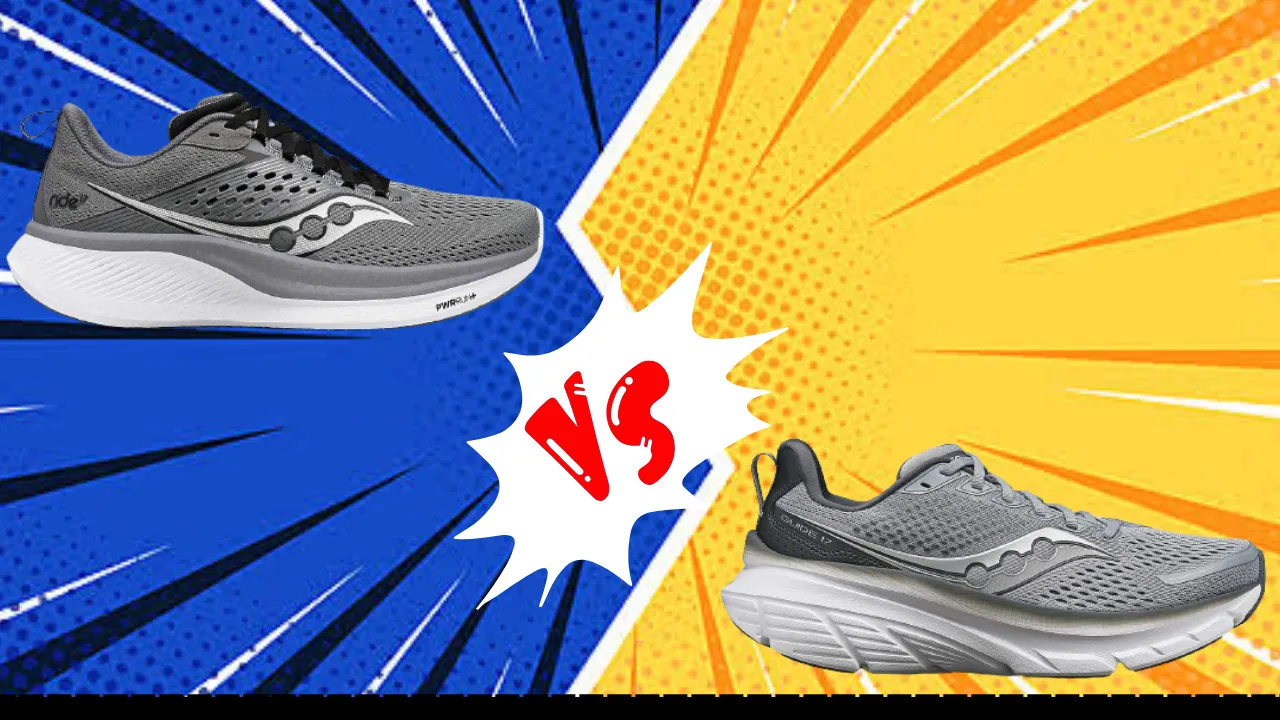Looking for your next pair of running shoes? The Saucony Ride 17 and Saucony Guide 17 are two of Saucony’s newest models designed to provide comfort, support, and responsive cushioning for daily training runs. But how do they compare when it comes to features, performance, and value?
Read on as we break down a detailed head-to-head comparison of Ride 17 and Guide 17 to help you decide which one is best for your running needs. With innovative midsole foams, engineered mesh uppers, and durable outsoles, both shoes aim to deliver a smooth, stable ride mile after mile.
Similarities And Differences Between Saucony Ride 17 And Guide 17:
| Feature | Saucony Ride 17 | Saucony Guide 17 |
|---|---|---|
| Launched In | 2024 | 2024 |
| Stability | Neutral | Stability |
| Flexibility | Moderate | Moderate |
| Sizing | Men’s 7-15, Women’s 5-12 | Men’s 7-13, Women’s 5.5-12 |
| Weight | 10.6 oz | 10.6 oz (M), 9.2 oz (W) |
| Cushion | PWRRUN+ | PWRRUN |
| Outsole | Carbon rubber | XT-900 rubber |
| Midsole | PWRRUN+ | PWRRUN+ |
| Upper | Engineered mesh | Engineered mesh |
| Retail Price | $140 | $140 |
Features Comparison:
Materials:
The Ride 17 uses a PWRRUN+ midsole made of lightweight and responsive foam that provides a good balance of cushioning and energy return. The outsole uses carbon rubber in high-wear areas for durability. The upper features an engineered mesh that is softer and more breathable than previous versions.


Guide 17 also utilizes a PWRRUN+ midsole but adds a medial post made of firmer foam on the inside of the shoe to prevent overpronation. The outsole is made of XT-900 rubber for traction and durability. The upper uses an engineered mesh that provides a secure fit.
Durability:
Both shoes are built to be durable for high mileage training, with solid rubber outsoles and cushioned midsoles that resist packing out or flattening over time. strategic rubber placement protects the outsoles from premature wear.
However, some users reported the Ride 17’s pull tabs were prone to tearing, likely due to the lightweight engineered mesh material. The tabs are purely decorative though, so durability is not compromised.
The Guide 17’s medial post is designed to maintain its structure for stability mile after mile without flattening or creasing excessively. The Guide 17 may have a slight edge in long-term durability thanks to the durable medial post.
Fit:
The Ride 17 fits true to size for most runners with a medium-width profile. The engineered mesh upper contours smoothly to the foot for a secure but non-restrictive fit. Ample cushioning cradles the foot comfortably without squeezing.


The Guide 17 runs slightly snug in the heel which helps keep the foot locked in place over the stability features, but midfoot and forefoot fit is secured comfortably by the lacing system. Those with wider feet may need to size up half a size in Guide 17 for a little extra room through the midfoot.
Stability:
The Ride 17 is a neutral shoe so it will accommodate neutral runners as well as mild overpronators who want cushion without prescribed motion control. While the midsole is soft, it still provides a stable platform for a smooth heel-to-toe transition.
The Guide 17 is a stability shoe specifically designed for moderate to severe overpronators, with its prominent medial post working actively to provide arch support and gently guide the foot through the gait cycle.
Cushioning:
Both models incorporate Saucony’s PWRRUN+ midsole foam which delivers responsive, cushioned energy return. The Ride 17 offers plusher, softer cushioning from heel to toe to attenuate shock. This makes it a great choice for recovery days and long slow runs.
The Guide 17 sacrifices some softness for a firmer ride under the medial arch, providing a rigid lever to efficiently stabilize each stride. The firmness also provides a propulsive toe-off while the Ride 17 has more shock absorption for high mileage.
Value:
With a $140 retail price, both the Ride and Guide 17 deliver premium features and technologies seen in more expensive shoes, making them a reasonable value for daily training. The Guide 17’s stability features make it a particularly great value for overpronators needing support.
The Ride 17 is a high-quality neutral trainer for those wanting responsive softness without breaking the bank. Overall, both models provide excellent value by balancing performance with affordability.
Performance Comparison:
Walking:
For daily walking and casual wear, the Ride 17 will likely feel much more comfortable and flexible thanks to its softer PWRRUN+ midsole that gently absorbs impact with each step. The engineered mesh upper also provides breathability.
Meanwhile, the Guide 17 may feel too stiff and restrictive for all-day walking comfort due to its firmer medial post and stability features which are engineered to control overpronation during runs, not casual walking. For natural walking motion, the Ride 17 is a better choice.
Running:
During runs, the Ride 17 delivers a stellar balance of plush heel-to-toe cushioning, versatility, flexibility, and responsive energy return – making it an ideal choice as a daily trainer for neutral runners wanting softness without losing bounce.
The Guide 17 is optimally suited for moderate overpronators who need extra medial arch support and motion control technology on runs to prevent excessive inward foot rolling and provide a stable platform, which helps prevent injury over time.
Plantar Fasciitis:
For runners specifically dealing with plantar fasciitis, the Ride 17 does provide adequate shock absorption for comfort, but the Guide 17 likely delivers better-enhanced arch support and targeted relief from symptoms thanks to its firmer medial post.
However, those suffering from more severe or chronic plantar fasciitis may need to consider stability shoes with maximum motion control and pronation correction like the Saucony Omni or Hurricane models.
Standing All Day:
If you’re on your feet all day as a teacher, nurse, doctor, retail worker, etc, the Ride 17 brings plush step-in cushioning and comfort that genuinely holds up well during very long-standing shifts without packing out.
The Guide 17, while still comfortable, may cause more foot fatigue and aches when standing for extremely extended 10+ hour workdays due to its firmer stability features that don’t cushion as softly. Overall, the Ride 17 is likely the better option for all-day wear.
Final Verdict:
The Saucony Ride 17 and Guide 17 are both high-quality daily trainers but are tailored to different running needs. Neutral runners will appreciate the Ride 17’s soft, flexible cushioning on any run while overpronators benefit most from the Guide 17’s enhanced stability.
If you need support for conditions like plantar fasciitis, Guide 17 provides better arch reinforcement as well.
However, the Ride 17 takes the lead when it comes to versatility and wearing the shoes for all-day wear or walking. Consider your biomechanics, running gait, and intended use when choosing between these two excellent models.

